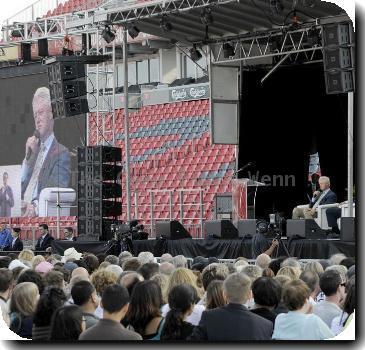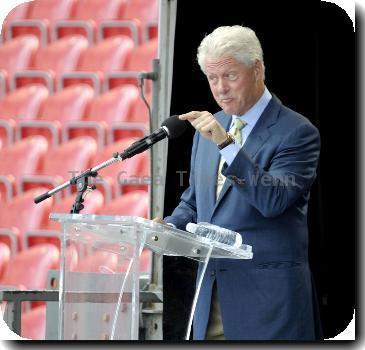Out of rubble of Haiti hotel, online family is born as Facebookers vow to leave no one behind
By Rukmini Callimachi, APWednesday, September 1, 2010
Facebook page leads search for loved ones in Haiti
PORT-AU-PRINCE, Haiti — The desperate quest to find loved ones started just minutes after the earthquake, as cell phones rang unanswered from beneath the rubble of Haiti’s best hotel.
A few hours later, the search went online with a Facebook page dedicated to the Hotel Montana. It was created by three siblings on Long Island, New York, looking for their missing uncle. Strangers immediately began to post names and photographs of their relatives. By the next morning, the site had received more than 50 messages from frantic families.
As the days passed and the death toll climbed, the number of members on the page grew until it reached 17,427 people from around the world. They called themselves “the family.” They adopted a profile picture of a rock inscribed with the word “Hope.” And they vowed to stick together until every last member of their online tribe was brought home, alive or dead.
“Though we’re all ready for this night to end and a faint glimpse of sunlight to illuminate the horizon, I’m fairly confident from getting to know you over the past several weeks that you’re ready to stand together,” wrote the site’s Tennessee-based moderator, Bob Allen, nearly two months after the quake. “Till the last one is home.”
The luxury $200-a-night Montana sat on a steep hill overlooking the capital. A visitor on TripAdvisor.Com compared it to “a vanilla wedding cake cascading down the wooded hillside.”
Over the years, the hotel acquired a reputation as a refuge from the country’s chaos. It was where Bill Clinton, the Rev. Jesse Jackson and Archbishop Desmond Tutu had stayed.
On Jan. 12, at least 100 people were booked in the hotel, and possibly as many as 100 more were on site for the weekly barbecue as well as a conference on neglected tropical diseases. Among them were Siegfried Francisco, head of civil aviation for the Caribbean island of Curacao, and his colleague, Auxencio “Angelo” Isenia, who were in Haiti for an air safety conference.
Before leaving home, Francisco, 57, remembered to give his wife money to rent a sailboat for his daughter Desiree’s 27th birthday that weekend. “In case I get held up,” he said as he headed out.
Aviation inspector Isenia also left a parting gift. On past trips, the 54-year-old had made a heart out of towels on the bed he shares with his wife. That morning, he glued a heart made out of toilet paper on the mirror. Then he made the letter U and glued it next to the heart, as in: “Love you.”
Among the Montana’s other guests was Roger Gosselin, 78, a Canadian professor recently retired from the University of Montreal, who had trouble booking a room because the hotel was sold out. He got a last-minute e-mail from a friend in Haiti: “My dear friend Roger, I was able to find a room for you at the Montana because you are my good friend!”
Before leaving, Gosselin sent his girlfriend of more than a decade an e-mail saying that he did not want to wake her and he loved her more than ever.
Gosselin arrived at the Montana around the same time as a group of college students who had spent the morning at an orphanage. The 12 students from Lynn University in Boca Raton, Florida, had agreed to forfeit their January vacation to do social work overseas.
Just after 4 p.m., Britney Gengel, a 19-year-old sophomore, called her mother to say, “Mom, this is what I want to do with the rest of my life … I want to start an orphanage.” Minutes later, her classmate Stephanie Crispinelli, also 19, called her father to say she too knew what she wanted to do with her life: Help the poor.
One of the last rooms went to Chrystel Cancel, 35, a USAID contractor who was late because she had missed her flight. She headed downstairs with her laptop in search of a Wifi signal to chat with her fiance. He had asked her to marry him three days earlier.
At 4:02 p.m., contractor David Apperson of Sparks, Georgia, had texted his wife to say he was planning to switch hotels because the Montana did not serve Bud Light.
__
It began at 4:53 p.m. with a terrible sound. The mountain started to tremble. The walls rippled. The hotel’s five stories folded like an accordion. In most of the rooms, the ceiling came to rest less than 1 foot off the carpeted floor.
Hundreds of miles away in Panama, Eric Nyman’s Skype screen went blank. Nyman, Chrystel Cancel’s fiance, had been chatting with her when she stopped responding in mid-sentence. He tried her cell. It went straight to voicemail.
In Curacao, Marydith Isenia, 51, was cooking beans, one of her husband Angelo’s favorite dishes, to thank him for the paper heart. Her son ran into the kitchen screaming, “Mom, mom — there’s been an earthquake in Haiti.”
Isenia looked up from the stove. Then she went back to stirring the beans. “It’s nothing,” she said, laughing. “He’s fine.”
__
In Long Island that night, Caitlin Fuentes, a 26-year-old teacher, her sister Lizzy and her brother Matt heard about the quake on the news. They Googled the hotel and found nothing other than sites taking reservations. So they created a group page for the Montana on Facebook and posted the name of their uncle.
Within minutes, the page was flooded with the names of those missing inside the hotel. The sisters grabbed a napkin and started making a list. By the time they got the phone call that their uncle was alive at 1 a.m. the next day, the napkin was overflowing with names. They started a spreadsheet.
In Curacao, Marydith Isenia’s son posted a picture of his stepfather in his aviation uniform. A few miles away on the same arid island, Desiree Francisco logged into Facebook. “Hoping everything is fine with my dad,” she posted on the same site.
In her condo in Montreal, Canada, 49-year-old administrative assistant Sylvie Leroux kept checking her inbox for a message from professor Gosselin, her companion. He called her ‘My Sylvie’ and liked to surprise her by leaving a freshly cut flower on her plate at dinnertime.
She addressed him directly on the Facebook page: “Roger we miss you so much,” Leroux wrote. “Where are you? We want to find you. I’ll take really good care of you — promise. YOUR Sylvie.”
__
In Haiti, the aftershocks continued to compress the Montana’s already crushed floors further down. Bodies piled up outside the hotel. The overpowering smell of death permeated the site.
Soon the ‘pile’ — as the destroyed hotel came to be called — was crawling with rescuers. It looked like an anthill.
It took two days for the rescuers to drill holes and penetrate the buried lobby. There they found a group of people entombed inside a space the size of a king-sized bed. They had survived by sharing a single lollipop.
On Wednesday, the parents of the missing college girls got a call from Lynn University, saying a security company hired to find the students had arrived.
“Now is the time to Pray for Britney to be found and be safe and sound!!! They have 2 Helicopters ready to evacuate them out!!!” her father, Len Gengel, posted from his computer in Rutland, Massachusetts.
Britney’s anguished parents contacted a local TV station to circulate her photograph. By the time a local TV crew arrived, the missing girl’s father was shouting into the phone.
“God is good! God is good!” he screamed. “She’s alive! They rescued her! … It’s a great day in this world!”
Lin Crispinelli, Stephanie’s mother, got the same call. Both families flew to Florida that night.
There, the Gengels were greeted by the president of the Boca Raton campus. With tears in his eyes, he told them there had been a mistake. It was not their daughters on the chopper.
They caught up with Lin Crispinelli in the lobby of her hotel. When they told her, she crumpled to the floor.
__
Cancel’s fiance, 37-year-old Nyman, got there on Day 4. He couldn’t find a flight to Haiti, so he flew to the neighboring Dominican Republic and hitched a ride across the border in an ambulance. He scrambled on top of the rubble and screamed out Chrystel’s name.
__
By the end of the first week, Facebook had identified at least 51 people from 11 countries still missing in the rubble. But the bodies pulled out were no longer recognizable.
Governments asked their citizens to provide detailed descriptions of loved ones, including jewelry and piercings. The descriptions went up on the Facebook page.
Angelo Isenia’s family in Curacao posted the list of jewelry he was wearing, including several rings and a cross.
Lorie Apperson, the wife of 45-year-old David Apperson, sent along a description of the barbed wire tattoo her husband, a Harley Davidson enthusiast, had engraved on his arm. And Stephanie Crispinelli’s brothers asked their mother to sit down and not get upset: Stephanie had recently gotten a tattoo of a small dove.
The death estimate for the quake grew from 80,000, to 120,000, to more than 200,000. U.S. families were asked to dial in to a daily State Department conference call.
“Everyday it was, ‘We have no new information.’ No new information. No new information,” said Lin Crispinelli. “You know as the days tick by that there’s only so long you can live without water.”
On Day 15, the Facebookers arranged to pray together at 11 a.m. Central time. At 11:03, a woman posted: “Praying in South Carolina.” The next post at 11:05 said: “Praying in Pensacola, Fl.” At 11:06, “Praying in Guatemala.”
They prayed in Colorado Springs and Los Angeles, in Vermont and Boca Raton, in Belgium, in Dar es Salaam, Tanzania, in Abidjan, Ivory Coast, in Pembrokeshire, Wales, in the Dominican Republic and in Minneapolis. More than two hours later, someone posted: “Still praying in Montreal.”
Every night, the group held a vigil, with members lighting a candle next to their computers. Many switched their profile to a picture of a burning candle.
On Jan. 22, the government announced that it was moving from a search for the living to an attempt to recover the dead.
__
Marydith Isenia stopped being able to sleep. She became forgetful. She still woke up at the same time every morning, then stared off into space for an hour or two. The paper heart on the mirror fell off.
She had met her husband five years earlier after surviving divorce. She had gone to mass every day to pray for a good man. Her son posted her picture on www.christiansingles.com. Angelo Isenia was the only other person registered on the Caribbean island.
On the 22nd of every month, the couple celebrated the day they married in December 2005. He sent her flowers. He wrote her poems. He asked her to put on a blindfold, then drove her to a romantic dinner.
This time Jan. 22 came and went. At work, her colleagues pretended not to notice when they found her weeping, mascara running down her cheeks.
On Feb. 1, she got the call. They sent a diplomatic pouch containing his ring, the cross he wore and his wallet. She refused to believe it was him.
The ceiling of the hotel had fallen across his chest. His head was spared, but from the neck down his body was flattened.
Marydith Isenia went to the funeral home and demanded to see her husband. They tried to hold her back.
“I said, I want to see my husband … I opened the door. I faced his face. I said, ‘Oh, it’s him.’ And then I left,” she says.
“And so I accepted what God had permitted. … I accept it,” she says. The tears slide down her face. “But I have pain,” she says, touching her hand to her chest.
__
It wasn’t until Day 25 that the searchers got close to the spot from where Chrystel Cancel had sent her last Skype message. They spotted her dusty bag. The searchers asked Nyman, her fiance who had never left the site, to leave the grounds for a few days.
They found her on Feb. 8. He lit a candle in the spot where she was. Her birthday had passed under the rubble. He bought a card and buried it. He sang her ‘Happy Birthday,’ tears streaming down his face.
__
By the middle of February, only eight members of the Facebook family still were missing.
Friends began to address them directly and even scold them about not coming home. They posted pictures of objects and places the missing people loved in an effort to make them ‘homesick.’ A picture of an ice-cold beer for Apperson. A picture of a motor home for Gosselin, who had bought his first just months before and was planning to go RV’ing with Leroux in the spring. A photograph of Curacao’s white sand beaches for Francisco.
They decided to honor the last man found as their ‘Captain,’ because only a captain refuses to leave his ship until all the other members of his crew have been rescued.
Sometime in February, the searchers found Stephanie Crispinelli’s journal. Her last entry describes the poverty she saw and how she wanted to help. Her flowing script ends in mid-sentence.
They also found a crushed camera. One of the pictures on the memory card is of Britney Gengel surrounded by pigtailed girls at the orphanage she had visited that morning.
Stephanie was found on Feb. 11. Three days later, on Valentine’s Day, Britney was pulled out of the rubble.
The searchers knew they were nearing a body when they saw the flies gathering. The cement excavator was turned off and they dug their way to the remains by hand.
Every day, sometimes twice daily, Sylvie Leroux posted Facebook messages to her ‘beautiful love.’
“Please come home, I feel like a ghost without you,” she posted one day. “So long as they haven’t found you, for me you are alive,” she said in another.
“Where are you,” she wrote in still another. “It hurts so much to live without you.”
As more bodies were recovered, there were fewer families on the U.S. State Department’s daily phone briefing, until it was just Lorie Apperson.
“Families kept saying, ‘thank you for finding my loved one,’” said 50-year-old Apperson. “And I felt happy for them. But I also felt like, what about me? What about David?”
David Apperson, 45, had gone to Haiti to bid on a project to build basketball courts. Weeks had passed, but his wife could not bring herself to touch or move his things, including the Harley parked in their garage. At the end of February, she got an e-mail asking if she still wanted to do the call. She said no.
It was inside the most pulverised sections of the hotel that the searchers found Gosselin and Apperson. Gosselin was getting ready to take a shower, with a razor in his clenched hand. On one of the upper floors, rescuers squeezed inside a void where they found the body of a man wearing cowboy boots. The forensic team that examined the body noted that there was a barbed wire tattoo on its arm.
“I have this image of David Apperson riding a Harley through the pearly gates. Instead of hearing harps and the angel band we’re hearing the rev of a V-twin engine,” posted a stranger on the site.
The Facebook group was down to just two missing men, Canadian Alexandre Bitton and aviation director Francisco of Curacao.
In the meantime, 27 unidentified bodies had been recovered from the mound of cement. They were buried during the wait for DNA results. Most were thought to be the hotel’s Haitian employees, whose relatives had never found the Facebook site.
A forensic team sent a sliver of bone from each for DNA analysis to a lab in Gaithersburg, Maryland. Many of the families already had received DNA kits. In Curacao, Desiree Francisco completed the mouthswab and sent it back.
On the 50th day, Facebook posted that Bitton’s body had been found. The next day, the moderator bestowed the title of Captain on Siegfried Francisco.
“That is altogether appropriate for a man who worked in aviation,” wrote Bob Allen, who had taken over moderating the site after the Fuentes family passed it on to other members of the Facebook group. “Captain Francisco, we salute you … and we’re all awaiting your return home.”
Untangling Francisco’s DNA took two months, twice as long as for anybody else. Desiree Francisco was his only child, so her DNA at most matched only half his genetic material. Also, the DNA culled from his decomposed bones was degraded, like a roll of film where half or more of the frames are overexposed.
Strangers lit candles and prayed for Francisco.
“I get off work at 5:30 tomorrow night, captain. you’d better be on your way home by then, too,” said Morgana Mouzon in San Diego, California.
“I feel like my daughter has gone out to the prom, and I am up waiting for her to get home,” posted another member. “I will not feel a true and complete sense of peace until Siegfried is located.”
On the outskirts of the capital is a rocky field. Ten feet below the surface is what remains of 27 human beings, carefully divided into 27 plots. On a sunny day in May, the forensic team from Houston-based Kenyon International returned with a metal detector, a backhoe and a priest wearing a white cassock.
The team combed the remote burial field with a metal detector. The men counted rows until they found the plot. The priest sprinkled the dirt with holy water.
The backhoe pulled up mounds of earth until they saw the metal box.
In Nashville, Tennessee, Facebook moderator Allen, 47, was walking through the houseware section of a department store with his wife on their anniversary when he got the text. In the middle of the aisle, he began to weep.
Later that night, he posted: “Our family is complete.”
The remains of Francisco’s body were placed inside a plywood coffin and loaded into the belly of a flight to Curacao. It took off into a gray sky. His immediate family was at his side. So was his online family, who exploded into a cascade of posts.
“Praise God!!!” wrote one woman in Lawrenceville, Georgia. “Welcome HOME Captain!” wrote another in Orlando, Florida.
From Long Island, where the site had begun, Caitlin Fuentes wrote: “It brings tears to my eyes thinking that every single person, every name that is etched in our hearts forever, has been returned to their loved ones,” she said. “Tonight, we rest in somewhat peace knowing everyone is home.”
It took 127 days for Francisco to return home from his final voyage. The clue to his identity was with him all along in a simple gold wedding ring inscribed with one word: “Hetty.”
Hetty Francisco, a petite brunette, stands for hours in the pew as mourners file past. At her side is Desiree. A slow-moving fan whirs above.
The hearse arrives escorted by a dozen police officers. The island’s flag is draped over the heavy wooden casket. The prime minister is in attendance.
In real life he was called ‘Dr. Francisco.’ But in the 4 1/2 months since his death, the name given to the last man off the mountain by his online family has stuck.
“Captain,” said one of the mourners as he stood in the nave of the church. “Your plane is ready for takeoff for your journey to heaven.”
The Montana Facebook site has now turned into a memorial, with an online album for each person lost and found. Sylvie Leroux still uses it to talk to the man who left flowers on her dinner plate.
“How I love you. With you I was. Now what am I?” she wrote in a recent post. “I am an amputated soul.”
Eric Nyman’s Facebook picture still shows him holding the pretty brunette whom he calls the love of his life. In the tab where Facebook users share a description of themselves, he has entered a single word: “Love.”
Each family has found its own way to remember.
Every Friday, Lorie Apperson buys two Bud Lights and heads to the cemetery to share a beer with her husband. She pours his next to his grave.
The Gengels are raising money to build the orphanage in Haiti that Britney had dreamed of. The Crispinellis are collecting donations to build a school for poor children in Stephanie’s memory. Both have made rubber bracelets bearing the names of their girls’ foundations.
Last month, Britney’s younger brother Bernie laid the bracelets next to each other in the white rubble that remains of the Montana. He snapped a photo. It was posted on Facebook.
And Hetty Francisco has taken to calling her husband’s cell phone and listening to his voice. In the recorded message, the Captain promises he will call back soon.
__
EDITOR’S NOTE — This story is based on dozens of interviews with the families and friends of those who died inside the Hotel Montana; survivors pulled out during the rescue effort; aid workers who helped recover remains; forensic experts who identified bodies; members and moderators of the Facebook site; diplomats from the Dutch consulate in Haiti and government officials in Curacao; and a review of archival photography of the Hotel Montana and of the WBZ TV footage of an interview with Len Gengel.
Online:
Hotel Montana Facebook site: www.facebook.com/ (search Hotel Montana)
Britney Gengel’s orphanage project: www.belikebrit.org
Stephanie Crispinelli’s school: www.stephaniesmission.org/
Tags: Bill Clinton, Canada, Caribbean, Curacao, Dominican Republic, Facebook, Florida, Forensics, Haiti, Latin America And Caribbean, Missing Persons, Montana, Montreal, Netherlands Antilles, New York, North America, Personnel, Quebec, Search And Rescue Efforts, United States




